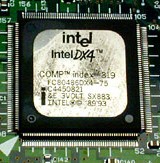
|
|
|
Chapter 6
Lesson 1 |
|
CS 103 Lesson 1
There are three general categories of translator programs:
assemblers, interpreters, and compilers. High-level program ----> Assembler, Interpreter, Compiler -----> Low-level instructions Source code ----> Assembler, Interpreter, Compiler -----> Object code Assembler languages use a set of abbreviated words (mnemonics) to represent the instruction set of the microprocessor. An assembler language program must be developed for each different microprocessor since their instruction sets are different. For example, every microprocessor contains a circuit that connects to a special part of the computer's memory called the accumulator. An assembler language for that microprocessor must then contain a mnemonic that generates the binary code that activates that particular function of the microprocessor. In the simulation program we will use later, that mnemonic is the LOD (pronounced LOAD) instruction. The programmer must memorize the mnemonics that are associated with the particular assembler language for a specific microprocessor. Once a program is written, the assembler translates the mnemonics into the binary instructions that control the microporcessor. Interpreters are programming languages that remove the programmer even farther from the microprocessor. Interpreted languages allow the programmer to use his/her own language to write programs. A single line of code may generate many machine language instructions. As you will see later, the single JavaScript statement total = cost + tax; would generate at least three machine language instructions. Interpreters generate the machine language instructions for a statement each time they encounter that statement. If a set of statements is contained in a loop, each statement is reinterpreted each time through the loop. Compilers are similar to interpreters in most respects. However, they differ in one important way. Compilers translate the entire program into machine language and then store those instructions in a separate file. Once a program has been compiled without error, it never needs to be translated again (unless the programmer changes the program). The following table compares the three types of translators.
|
